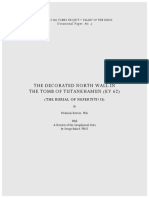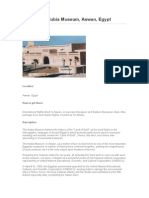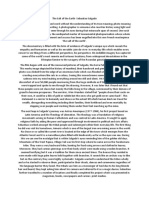The Significance of Incense and Libations in Funerary and Temple Ritual
The Significance of Incense and Libations in Funerary and Temple Ritual
Uploaded by
Shihab EldeinCopyright:
Available Formats
The Significance of Incense and Libations in Funerary and Temple Ritual
The Significance of Incense and Libations in Funerary and Temple Ritual
Uploaded by
Shihab EldeinOriginal Title
Copyright
Available Formats
Share this document
Did you find this document useful?
Is this content inappropriate?
Copyright:
Available Formats
The Significance of Incense and Libations in Funerary and Temple Ritual
The Significance of Incense and Libations in Funerary and Temple Ritual
Uploaded by
Shihab EldeinCopyright:
Available Formats
191-2.] Α. Μ. BI.ACKMAN: T h e Significance of Incense and Libations.
69
The Significance of Incense and Libations in Funerary
and Temple Ritual.
Bv AYLWARD M. BLACKMAN.
In the Ritual of Amon1 XII 7-10 a strange idea about the nature of incense is
found, which can, however, be fully explained in the light of a similar belief
about libations of water" that occurs in the Pyramid Texts. This perhaps
accounts for the important place which the offering of both holds in the mor-
tuary and temple services, and for the fact that they are often presented simul-
taneously3 or in immediate succession4.
Let us first consider the following libation-formulie from the Pyramid Texts.
(1) Pyramid 22-23.
y^^çj^û
o Œ ρ
"These thy libations Osiris! These thy libations o Unas, which
have come forth before thy son, which have come forth before Horus!
I have come I have brought to thee the Horus-eye that thy heart may
be cool possessing it I offer thee the moisture that has issued
from thee, that thy heart may not be still possessing it 5 ."
(2) Pyr. 765-66.
ν ~-t> I -ν * LA -ire) v — « /WWW .mil o Jarç* ΛΛΛΛΛΛ I
ΛΛΛΛΛΛ
*) P u b l i s h e d by MORET in the Annales du Musée Guimet u n d e r the title of de Rituel du Culte
divin journalier en Egypte.
Ρ Λ ¿J YWWVA JY ΛΛΛΛΛΛ
2 ) Called ^î Ö ΙΌ in P y r . 22, 7 6 5 . 7 8 8 and W in P y r . 8 6 8 and ¡ n P y r . 1360.
^¿J Χ IÄ * Λ/WWV 1Δ ΛΛΛ/^Λ
3 ) S e e f o r e x a m p l e MARIETTE, A b y d o s I p. 7 2 , 3 2 e tableau.
4 ) See SETHE, Pyramidentexte 1 7 - 2 4 w h e r e incense p r e c e d e s libation.
5 ) ρ i. e. the H o r u s - e y e which h e r e of c o u r s e is the libation.
Brought to you by | New York University Bobst Library Technical Services
Authenticated
Download Date | 11/24/15 12:47 PM
70 Α. Μ. BLACKMAN: The Significance of Incense and Libations. [50. Band.
"0 Osiris Pepy, I offer to thee these thy libations, libations for
thee before Horus, in thy name of Pr-in-kbh. I offer to thee natron
(ntr) that thou mayest be divine. T h y mother Nut has caused thee to
be a god unto thy enemy in thy name of " G o d . " I offer to thee the
moisture that has issued from thee."
(3) Pvr. 868.
" O Mernerê, thy water, thy libation, the great flood that issued
from t h e e ! "
(4) Pyr. 2007.
"Thy water belongs to thee, thy flood belongs to thee, thy fluid
belongs to thee that issued from Osiris."
(5) P y r . 2031.
η ΛΛΛΛΛΛ
ΛΛΛΛΛΛ
ΑΛΛΛΛΛ <
V- -Λ
~ — Λ
TÍ
—
Λ/VWA
J
^ Λ,
Π q ^
8 -$5»*
fi Χ λ.
^
λλΛΛΛΛ
ΛΛΛΛΛΛ
-cr^s
ΛΛΛΛΛΛ [ | η
t\
J W i - C E
J
Ü
"Thy water belongs to thee, thy fluid belongs to thee, thy flood
belongs to thee that issued from Osiris."
(6) P y r . 1360 (P. 608).
s <v s VI [-| ΛΛΛΛΛΛ ΛΛΛΛΛΛ Π Q ΛΛΛΛΛΛ ΛΛΛΛΛΛ
Λ α ^ ^ π Μ 1 J R V'
• — Τ) \ Ά WWV\ ΛΑΛΛΛΛ Λ J] Α ΛΛΛΛΛΛ V ^ Ι ^ Ι ϊ\
" R a i s e thyself up o illuminated one, o Mernerê! T h y water belongs
to thee, thy flood belongs to thee, thy fluid belongs to thee that issued
from the corruption of Osiris."
(7) Pyr. 788 (P. 66).
" T h e offering of libations. T h y water belongs to thee, thy flood
belongs to thee, the fluid that issued from the god, the exudations that
issued from Osiris."
Brought to you by | New York University Bobst Library Technical Services
Authenticated
Download Date | 11/24/15 12:47 PM
1912.] Α. Μ. BLACKMAN: The Significance of Incense and Libations. 71
The general meaning of these passages is quite clear. The corpse of the
deceased is dry and shrivelled. To revivify 1 it the vital lluids that have exuded
from it must he restored, for not till then will life return and the heart beat
again. This, so these texts shew us, was believed to be accomplished by offering
libations to the accompaniment of incantations.
In examples (1), (2), and (3) the libations are said to be the actual lluids
that have issued from the corpse". In (4), (5), (6), and (7) a different notion
is introduced. It is not the deceased's own exudations that are to revive his
shrunken frame but those of a divine body, the that came from the
corpse of Osiris himself, the juices that dissolved from his decaying llesh, which
are communicated to the dead sacrament-wise under the form of these libations.
Let us now turn to Ritual of Anion XII 7-10, the passage already alluded
to, which is as follows.
Rit. Amori X I I 7 (MORET p. 115).
.ΛΛΛΛΛΛ
') That the dead was supposed to be revivified by the libation is shown by the words
_n_ ^ ^ p. Wrd ib "still of heart" is the regular epithet of the dead Osiris with
whom the deceased is identified. By means of libations the heart no longer remains "still," and
so the dead lives again as did Osiris thanks to the ministrations of Horus.
. CT73 I]
3) Cf. Pap. RhiricJ. p. 12, 6. Quoted by BRUGSCH, Wörterbuch p. 881. ^
In the late period the supposed ^^ 0 o°° of Osiris were preserved in the Serapeum
which then existed in every nome (see BRUGSCH, D. G. p. 443). BRUGSCH loc. cit. also quotes in-
scriptions at Dendera which speak of the ||f| (j "the fluid of ìny (Osiris-Serapis)," and
Ί * yL φ " T h e god's fluid is in a vase."
The Nile was supposed to be the q jj 1 " w h'ch issued from Osiris" or
"j " T h e god's fluid." The expression ^ ^ ' ' J \ (j A in the Pyramid texts may
refer to this belief — , the dead as usual being identified with Osiris — since the water used in
libations was Nile-water, drawn according to the ritual texts in the 1 st Cataract region where the
river was supposed to come pure from its source. For an early example of this see Pyr. 834
- - -- -—
MANN, Hierogl. Inschriften p l . L V I Γ^-Ί φ | and ibidem pl. L V I I I .
4) ^(Ç refers to | μ which is perhaps treated as a singular;' See ERMAN, Glossar p. 80,
who seems to doubt whether ^ j ^ really is a plural.
Brought to you by | New York University Bobst Library Technical Services
Authenticated
Download Date | 11/24/15 12:47 PM
72 Α. M. BLACKMAN: The Significance of Incense and Libations. [50. Band.
ΛΛΛΛΛΛ I Q ΛΛΛΛΛΛ
ΜΜί,Ύ,
® ? Ill<=> c=a " ' 1
" T h e god comes with body adorned which he has fumigated with
the eye of his body, the incense of the god which has issued from
him, and the odour of the fluid which has issued from his flesh, the
sweat of the god which has fallen to the ground, which lie has given
to all gods It is the Horus-eye. If it lives, the people (rhy-t) live,
thy flesh lives, thy members are vigorous."
In the light of the Pj-ramid libation-formulai the expressions in this text
are quite comprehensible. Like the libations the grains of incense are the
exudations of a divinity, " t h e fluid ( ^ ) which issued from his flesh.
\ c^) <=» 111 /
the god's sweat descending to the ground."
In Ritual of Amon XII 1 1 2 much the same idea about incense again occurs.
5(Mpf 3 ^Pto^lsllfil^^lk^lI'M
JA I
J\ ^
ι
ΛΛΛΛΛΛ I \ 1
" The incense comes (twice), the perfume of the god comes,
the odour of the god comes, the grains (?) [of incense] come, the sweat of the
god comes."
Here incense is not merely the "odour of the g o d " but the dgiw, or
grains of resin, are said to be " t h e god's sweat."
Finally in a Middle Kingdom mortuary text (AZ. 47 p. 126) incense is
called ^ ^ f f H J " t h e god's dew."
MORET seems to have misunderstood the significance of the first of these
two extracts from the Ritual of Amon. He renders ^ ^ Ω f^i to H I
^ jX V by " Les résines du dieu sortent de lui pour parfumer les humeurs sorties de
ses chairs divines, les sécrétions tombées à terre. . Tous les dieux lui ont donné ceci."
In his commentary he maintains that the use of incense is here purificatory
and compares Pyr. 8 5 0 , and Pyr. 1 8 0 1 which are formulae for purification by
natron and ointment (md-t) respectively. In those two instances the fd-t is an
unpleasant thing to be got rid of, not a sweet smelling excretion that is to
be "given to all gods."
ΛΛΛΛΛΛ
') ^ © = Ρ \\ (see ÄZ. 49, 24), referring to ΛΛΛΛΛΛ
7| J
3 ΛΛΛΛΛΛ
Cl
2) See also Rit. Amon X X V 6 where incense is called ΛΛΛΛΛΛ < = >
. ΛΛΛΛΛΛ .
I II ΛΛΛΛΛΛ J1
3) Cf θ / ^ -ji^» NAVILLE, Deir el-Bahri II 47.
ΛΛΛΛΛΛ 1 ΛΛΛΛΛΛ P - ^ - O
*) T h e perfumed " s w e a t " of the god is also the result of his being fumigated with incense
(see Urk. IV 8 7 4 , 1. 9).
Brought to you by | New York University Bobst Library Technical Services
Authenticated
Download Date | 11/24/15 12:47 PM
1912.] Α. Μ. BLACKMAN: The Significance of Incense and Libations. 73
Moreover I can find no example of |l ^ used as a verb, and α
— Τ η ^ ι | can only be a relative sentence. ^J. <2, as is often the case in
New Egyptian, is for [1 \\ .
The rendering I suggest is supported by the Pyramid libation-formulae,
by Ritual of Anion XII 11 and X X V 6, where, as we have seen, incense is called
» an( l by the parallel expression i ] ^ ' H f 1 ' ^ ^ À-Z. 47 p. 1*26.
^ is merely the connective (ERMAN
ΛΛΛΛΛΛ
Gramm?) joining
J
P ^ ^ to ^ ^ J"^
which is in apposition to ^ .
a
Although incense as well as water mixed with ^ and other solubles, such as
and δ i " ^ o , were regularly employed for the purpose of purifications
Ο Ο Ο Α ΛΛΛΛΛΛ O
in both temple and mortuary chapel, this passage, which is now under dis-
cussion, no less than the libation-formulae already dealt with, is concerned with
a sacramental and not a purificatory rite.
By the term "sacramental" rite of libation or incense we mean that under
the form of these offerings certain virtues and powers were supposed to be mys-
teriously imbibed by the recipient. W e had already seen that this is so in
the case of libations in the Pyr. Texts, and we now find the same belief expressed
about incense. Thus in Ritual of Amon~&\l 10 we r e a d : — " I t (the incense) is
the Horus-eye. If it lives, the Rekhyt live, thy flesh lives, thy members
flourish." Like the body of the dead that of the god's 2 too is conceived of
as shrivelled and dry and needing its moisture restored to it, which is, as
we see, accomplished by fumigating him with " l i v i n g " incense, the grains of
which are the crystallised exudations from a divine body. This idea occurs
nomimi
also in the Middle Kingdom mortuary text already quoted from (AZ. 47 p. 126)
Τ* R M E S S I M I
s—> " H e r head is fumigated with incense. This N. is vigorous by means of
incense. The god's dew [approaches] towards thy flesh."
There is still one doubtful point in Ritual of Anion XII 8. Is Τ 3
I C S ΛΛΛΛΛΛ
the exudations of the god who is fumigated or those of Osiris? The object
of the rite is not affected, whatever view may be taken, for in either case it
is performed to enable the corpse to regain its lost moisture. In the libation-
ΛΛΛΛ
, ^ must mean the "Horus-eye" that is to say the offered incense, though
owing to some mistake or misunderstanding it is here spoken of as the eye of the god who is
being fumigated!
*) The fact that, owing to the influence of the Osiris-myth, the cult of the gods was in
many respects so far identical with that of the dead, that the deities were addressed and ministered
to every morning as though they were corpses needing to be revivified, requires no comment here.
Zeitachr. f. Agypt Spr., 50. Band. 1912. 10
Brought to you by | New York University Bobst Library Technical Services
Authenticated
Download Date | 11/24/15 12:47 PM
74 Α. M. BLACKMAN : The Significance of Incense and Libations. [50. Band.
formulae we found that both these ideas occur, for according to three of them
the liquids offered are the actual exudations of the deceased, while in the other
two they are said to be those of Osiris. But the expression at the end of
line 8 " w h i c h he hath given to all g o d s " suggests that Osiris is meant, since
it is not likely that every god was supposed to give his " s w e a t " for the
benefit of all gods.
This view is also supported by the expression (j ® in the Middle
ΛΛΛΛΛΛ
Kingdom incense-formula already quoted, which concludes t h u s : — ^ ^ O
ο ί O O O
sic sic
Jî»^ J á " i n c e n s e comes (twice). The grains1 [of incense?] come (twice).
The toe comes. The back-bone of Osiris comes forth. The natron (?) comes
(twice). The members come which issued from Osiris." Here most certainly
incense which has just been called " t h e god s d e w " is connected with Osiris
and parts of his body, the virtues of which are doubtless supposed to be
communicated to the deceased by fumigation.
W e seem therefore to have good ground for asserting that in the phrase
Ί!<Ξ>ίπι—15no l e s s t h a n in Ξ ^ Ξ Μ [pyr- 788] "the g o d " i s 0siris "·
I can find no instances in the Pyramid Texts in which incense ' is spoken
of in the terms used in the Ritual of Amon and the Μ. K. funerary text. There
this belief seems to have been attached to certain libations only. But even in
the Pyramids incense, which is the gift of the Nubian god Dedwen 4 , is not
always merely purificatory. Through the medium of the smoke mounting up from
the censer, the deceased can enter into communion 5 with certain gods who are
accompanied by their Kas, and, apparently, he can at the same time be reunited
M Cf. ττ in Rit. Amun X I I 11. Between this and the M. K . text there is a
S J m o m
general resemblance and ¡¡¡¡EXS^ corresponds to (j ö l'|j|||J ^ in the preceding part of
the latter.
2) So in ^ "the god's fluid," a name for the Nile, quoted in the footnote on p. 71,
-j, ι ι
Osiris is meant, as is clearly proved by the parallel ^ J\
3) Somewhat analogous is the formula which mentions the
Ρ o ^ ^ ^ Pyr. 378, and also Pyr. 116 quoted below where mn-wr is said to be (j -JJ- ^ ^ ^ ^ .
Here, however, Horus is their source, from which they emanate, and not Osiris.
*) Pyr. 1017 and P y r . 1718.
5) For this idea see also Pyr. 376 where the cloud of smoke is alluded to in ^ ^ J ΛΛΛΛΛΛ
%-T o
Brought to you by | New York University Bobst Library Technical Services
Authenticated
Download Date | 11/24/15 12:47 PM
1912.] Α. Μ. BLACKMAN: The Significance of Incense and Libations.
with his own K a . " O Unas, the arai of thy Ka is in front of thee! O Unas,
the arm of thy Ka is behind thee! etc." Pyr. 17-18.
Also like other offerings it was supposed to possess a divine personality 1
The conclusion would seem to be as follows. Although O this belief about
incense apparently does not occur in the 01(1 Kingdom religious texts that are
preserved to us, yet it may quite well be as ancient as that period. That is
certainly E R M A N S view with regard to the "Ritual of Amon" as expressed in his
" Handbook of Egyptian Religion ' p. 46. If that is the case, it becomes quite
obvious why the burning of incense and the pouring of libations are so closely
associated in the funeral and temple ritual. Both rites are performed for the
same purpose— to revivify the body of god or man by restoring to it its
lost moisture. Under the form of libations it was believed that either the
actual fluids that had run from it, or those of Osiris himself, were communi-
cated to the corpse. In the case of fumigation with incense it is the latter
of these two ideas that seems to have prevailed, namely that the body was
revivified not by the restoration of its own exudations but by receiving those
of Osiris".
') S e e for example Pyr. 376 c; Ritual of VOTOTI VII 9 where, as also in MACIVER, Buhen
p. 50, incense is identified with Nhb-t·, and AZ. 47 126-127 where the divine personality of
is indicated by the determinative . Cf. also Ritual of Amon X X X 4, where, when the «¿mj-bandage
offered, part of the formula w a s : — | j ^ <—a^j . W e might also compare id. 1 , 5
where the different parts of the censer are addressed as divinities (see MORET, Rituel du Gülte
divin p. 16 for an excellent footnote on this point).
2 ) Does this idea lurk also in a Totentext commented on by SETHE in AZ. 47, 71, which in
ΛΛΛΛΛΛ ^
connection with speaks of ^ ®Γθ a n d ΛΛΛΛΛΛ
/WSA™ ΣΣ
x
S
ojt?
Brought to you by | New York University Bobst Library Technical Services
Authenticated
Download Date | 11/24/15 12:47 PM
You might also like
- EA 33pp21 24parkinsonDocument4 pagesEA 33pp21 24parkinsonPablo V. La Confra100% (1)
- SAVE SODERBERGH - On Egyptian Representations of Hippopotamus Hunting As A Religious MoriveDocument61 pagesSAVE SODERBERGH - On Egyptian Representations of Hippopotamus Hunting As A Religious MoriveSebastián Francisco MaydanaNo ratings yet
- Acta Hyperborea 12 2009-LibreDocument32 pagesActa Hyperborea 12 2009-LibreGermanikNo ratings yet
- Mes AynakDocument60 pagesMes AynakNarasimha DasNo ratings yet
- The Decorated North Wall in The Tomb of PDFDocument83 pagesThe Decorated North Wall in The Tomb of PDFI Hernandez-FajardoNo ratings yet
- Ancient Egypt - DwarfsDocument6 pagesAncient Egypt - Dwarfssideron99No ratings yet
- The Bird at The Back of The Atef CrownDocument39 pagesThe Bird at The Back of The Atef CrownMirković JelenaNo ratings yet
- 2018 Final Program For SAAwebDocument322 pages2018 Final Program For SAAwebHirokazu KotegawaNo ratings yet
- A Amnual of Egyptian PotteryDocument309 pagesA Amnual of Egyptian PotteryTomislavMenalo100% (1)
- Arkell 1955 Hator PDFDocument3 pagesArkell 1955 Hator PDFFrancesca Iannarilli100% (1)
- AJA No.3Document902 pagesAJA No.3zlatkoNo ratings yet
- For The Temples For The Burial Chambers.Document46 pagesFor The Temples For The Burial Chambers.Antonio J. MoralesNo ratings yet
- Scribal Training in Ancient EgyptDocument9 pagesScribal Training in Ancient EgyptAdam T. AshcroftNo ratings yet
- The Wine Jars Speak A Text StudyDocument191 pagesThe Wine Jars Speak A Text StudyPaula VeigaNo ratings yet
- AbusirandSaqqara2010 Dulikova WebDocument116 pagesAbusirandSaqqara2010 Dulikova WebAlex Moore-MinottNo ratings yet
- Çatalhöyük Archive Report 2009Document180 pagesÇatalhöyük Archive Report 2009Jason QuinlanNo ratings yet
- Loufty Boulos - Grasses in Ancient EgyptDocument6 pagesLoufty Boulos - Grasses in Ancient EgyptRicardo MadridNo ratings yet
- Hendrickx JEA 82Document22 pagesHendrickx JEA 82Angelo_ColonnaNo ratings yet
- The Nubia MuseumDocument3 pagesThe Nubia MuseumNabil Roufail100% (1)
- Neolithic Age in Iran-F. HoleDocument10 pagesNeolithic Age in Iran-F. HolearadmilovNo ratings yet
- Gardiner, AH - The Inscriptions of Sinai Vol I (1917)Document113 pagesGardiner, AH - The Inscriptions of Sinai Vol I (1917)khaledgamelyanNo ratings yet
- Ancient Egyptian Art Forms Are Characterized by Regularity and Detailed Depiction of GodsDocument4 pagesAncient Egyptian Art Forms Are Characterized by Regularity and Detailed Depiction of GodsManishaNo ratings yet
- Pigeon-Raven and Sperm Whale, Magical Objects and Domestic Horned. The Division of The World During The Early Neo-Neolithic in Western FranceDocument8 pagesPigeon-Raven and Sperm Whale, Magical Objects and Domestic Horned. The Division of The World During The Early Neo-Neolithic in Western FranceaustronesianNo ratings yet
- Egyptomania in Hellenistic Greece - A Study Based On Water in The Cult of IsisDocument28 pagesEgyptomania in Hellenistic Greece - A Study Based On Water in The Cult of IsisChr BurNo ratings yet
- Egypt Exploration SocietyDocument6 pagesEgypt Exploration SocietyFady Nagy BotrosNo ratings yet
- ExtremistDocument76 pagesExtremistBryan Pitkin100% (1)
- Povestea Marinarului Naufragiat, Regatul de Mijloc (Christian Casey) PDFDocument124 pagesPovestea Marinarului Naufragiat, Regatul de Mijloc (Christian Casey) PDFcristidumi-1100% (1)
- Sackler Gallery of Egiptian AntiquitiesDocument142 pagesSackler Gallery of Egiptian AntiquitiesSandra FerreiraNo ratings yet
- New Kingdom Stelae in Serabit El-KhadeinDocument3 pagesNew Kingdom Stelae in Serabit El-Khadeinosir7100% (1)
- Hubicky V EgypteDocument14 pagesHubicky V EgyptePierre-Alexandre NicolasNo ratings yet
- Some Post-Old Kingdom Pottery From GizaDocument34 pagesSome Post-Old Kingdom Pottery From GizaanatavaresaeraNo ratings yet
- Kanawati - Report 8 Part 2 PlatesDocument68 pagesKanawati - Report 8 Part 2 Platesmenjeperre100% (1)
- Mariya Ivanova - The Black Sea and The Early Civilizations of Europe, The Near East and Asia-Cambridge University Press (2013)Document410 pagesMariya Ivanova - The Black Sea and The Early Civilizations of Europe, The Near East and Asia-Cambridge University Press (2013)alexeiNo ratings yet
- 2013ABCANGM NatufianForagersDocument25 pages2013ABCANGM NatufianForagersbayram kaçarNo ratings yet
- End of Early Bronze AgeDocument29 pagesEnd of Early Bronze AgeitsnotconfidentialsNo ratings yet
- The Karnak Temple ComplexDocument4 pagesThe Karnak Temple ComplexAnkita Roy ChowdhuryNo ratings yet
- Mehu Saqqara EJARS - Volume 2 - Issue 2 - Pages 109-118Document10 pagesMehu Saqqara EJARS - Volume 2 - Issue 2 - Pages 109-118Renata Tatomir100% (1)
- Garnot - A Hymn To Osiris in The Pyramid Texts - 1949Document6 pagesGarnot - A Hymn To Osiris in The Pyramid Texts - 1949rupert11jgNo ratings yet
- Healy Et Al. - 1996 - Precolumbian Obisidian Trade in The Northern Intermediate Area Elemental Analysis of Artifacts From Honduras AnDocument55 pagesHealy Et Al. - 1996 - Precolumbian Obisidian Trade in The Northern Intermediate Area Elemental Analysis of Artifacts From Honduras AnKukii Fajardo CardonaNo ratings yet
- Decoding Indus ScriptDocument232 pagesDecoding Indus ScriptgreenspeakryanNo ratings yet
- Griffith StelaeDocument27 pagesGriffith StelaeSophia PhiloNo ratings yet
- Qubbet El HawaDocument2 pagesQubbet El HawaujiNo ratings yet
- The Temple of Tell BastaDocument3 pagesThe Temple of Tell BastaAhmed Mansour100% (1)
- Tutankhamuns Mask Reconsidered in PressDocument17 pagesTutankhamuns Mask Reconsidered in PressJosé Eduardo Baravelli0% (1)
- Childbirth Votives and Rituals in Ancient Greece PDFDocument334 pagesChildbirth Votives and Rituals in Ancient Greece PDFjmagil6092100% (3)
- Morsch Michael Magic FigurinesDocument19 pagesMorsch Michael Magic Figurinesuivar09100% (1)
- Selim Hassan, The Excavations at Giza 3Document382 pagesSelim Hassan, The Excavations at Giza 3Dr-Abdul Rahman Al-AyediNo ratings yet
- Thesis On On Inner Sanctuary of Ptolemaic Period TemplesDocument650 pagesThesis On On Inner Sanctuary of Ptolemaic Period TemplesAankh Benu100% (1)
- Egyptian Scribal PowerDocument17 pagesEgyptian Scribal PowerMauricio SchneiderNo ratings yet
- Roman Beliefs in SuperstitionDocument11 pagesRoman Beliefs in Superstitionapi-485972687No ratings yet
- MA Thesis Iris Dansen Sons of HorusDocument63 pagesMA Thesis Iris Dansen Sons of HorusОктай СтефановNo ratings yet
- Nabta Playa and Its Role in Northeastern African PrehistoryDocument27 pagesNabta Playa and Its Role in Northeastern African Prehistorydoerflinger8448100% (1)
- OLA205 Debowska LudwinDocument18 pagesOLA205 Debowska Ludwinjoanna_debowska-ludwinNo ratings yet
- Aram17 2005 Patrich Dionysos-DusharaDocument20 pagesAram17 2005 Patrich Dionysos-Dusharahorizein1No ratings yet
- Stela Workshops of Early Dynasty 12Document40 pagesStela Workshops of Early Dynasty 12Asmaa Mahdy100% (1)
- Chikovani-Chained Amirani-1966Document146 pagesChikovani-Chained Amirani-1966iaqsarNo ratings yet
- Proceedings of the Ninth International Dakhleh Oasis Project Conference: Papers presented in honour of Anthony J. MillsFrom EverandProceedings of the Ninth International Dakhleh Oasis Project Conference: Papers presented in honour of Anthony J. MillsColin A. HopeNo ratings yet
- The Sarcophagus of Hunefer and other New Kingdom Private SarcophagiFrom EverandThe Sarcophagus of Hunefer and other New Kingdom Private SarcophagiNo ratings yet
- Technological Approach to Lithic Artifacts from Yukon TerritoryFrom EverandTechnological Approach to Lithic Artifacts from Yukon TerritoryNo ratings yet
- H. R. Hall, The Relations of Aegean With Egyptian Art IIDocument13 pagesH. R. Hall, The Relations of Aegean With Egyptian Art IIShihab EldeinNo ratings yet
- A. Lucas, The Austrian Excavations, 1914 Excavations of The Vienna Imperial Academy of Sciences At, P. 250Document7 pagesA. Lucas, The Austrian Excavations, 1914 Excavations of The Vienna Imperial Academy of Sciences At, P. 250Shihab EldeinNo ratings yet
- Polis 2020 HieraticPalaeography OUP PrintDocument8 pagesPolis 2020 HieraticPalaeography OUP PrintShihab EldeinNo ratings yet
- Recueil de Travaux RelatifsDocument7 pagesRecueil de Travaux RelatifsShihab EldeinNo ratings yet
- 3 CairoDocument1,242 pages3 CairoShihab Eldein0% (1)
- TM PG Rid N or TH: Tru en OrthDocument1 pageTM PG Rid N or TH: Tru en OrthShihab EldeinNo ratings yet
- 2010 Ptolemaic HieroglyphsDocument11 pages2010 Ptolemaic HieroglyphsShihab EldeinNo ratings yet
- KV 43Document2 pagesKV 43Shihab EldeinNo ratings yet
- 3 CairoDocument1,242 pages3 CairoShihab Eldein0% (1)
- KV 14Document2 pagesKV 14Shihab EldeinNo ratings yet
- HaggadotDocument49 pagesHaggadotWalter Javier LeyvaNo ratings yet
- Narasimha HomaDocument40 pagesNarasimha HomaDurga PrasadNo ratings yet
- 600 Years of Craft MasonryDocument16 pages600 Years of Craft MasonryJerryNo ratings yet
- Daily Living DuasDocument2 pagesDaily Living DuasAddNo ratings yet
- Divali 2001Document48 pagesDivali 2001Kumar MahabirNo ratings yet
- Rosh Hashanah - Zohar Scanning PortionsDocument83 pagesRosh Hashanah - Zohar Scanning PortionsAdriana Lema100% (3)
- The Birth of Jesus ForetoldDocument2 pagesThe Birth of Jesus ForetoldShereen LinaNo ratings yet
- The Salt of The EarthDocument2 pagesThe Salt of The EarthsmitaNo ratings yet
- Genesis Chapter 31Document6 pagesGenesis Chapter 31William DuoduNo ratings yet
- Glory To God Dan SchutteDocument2 pagesGlory To God Dan SchutteKevin Paul Cero67% (3)
- Charles Stewart Dept of Anthropology University College London C.stewart@ucl - Ac.ukDocument22 pagesCharles Stewart Dept of Anthropology University College London C.stewart@ucl - Ac.ukapi-25923192No ratings yet
- Rishi Prasad - 190 Oct 08Document20 pagesRishi Prasad - 190 Oct 08gurusewaNo ratings yet
- Water BaptismDocument4 pagesWater BaptismGatdaet GatnogNo ratings yet
- Reading 1: Thursday of The Fourth Week of Lent Lectionary: 247Document2 pagesReading 1: Thursday of The Fourth Week of Lent Lectionary: 247Honiel PagoboNo ratings yet
- Kids Church Teaching Material On EstherDocument18 pagesKids Church Teaching Material On EstherghostNo ratings yet
- Padmanabhaswamy TempleDocument12 pagesPadmanabhaswamy TempleKarthikeya SaiNo ratings yet
- Lead SheetDocument3 pagesLead SheetjenNo ratings yet
- The Ritual Process by TurnerDocument5 pagesThe Ritual Process by TurnerYehonatan Elazar-DeMota100% (1)
- 21 Ways God SuppliesDocument2 pages21 Ways God Suppliesbayo_akande8912No ratings yet
- Boboteaza and Dreaming of Prince Charming: Swimming in Frozen Waters After A CrossDocument4 pagesBoboteaza and Dreaming of Prince Charming: Swimming in Frozen Waters After A Crossalina_sicaNo ratings yet
- The Yukaghir Tribe: Submitted By: Prableen Gujral FD VDocument10 pagesThe Yukaghir Tribe: Submitted By: Prableen Gujral FD VPrableen GujralNo ratings yet
- Pauranika PrayogaDocument120 pagesPauranika PrayogaYogendra ShastriNo ratings yet
- Inaugration of Mayor and SB ScriptDocument6 pagesInaugration of Mayor and SB ScriptJun Greg MaboloNo ratings yet
- Squire Parsons: 1944 - PresentDocument2 pagesSquire Parsons: 1944 - Presentapi-271721978No ratings yet
- Mystic Powers of KaliDocument13 pagesMystic Powers of KaliaghorishivaNo ratings yet
- Liturgical Theology Part 1Document42 pagesLiturgical Theology Part 1jedNo ratings yet
- Draft 2Document9 pagesDraft 2api-286285377No ratings yet
- Freemasonry and The Civil WarDocument10 pagesFreemasonry and The Civil WarMike Burgess0% (1)
- Prayerbook For Religious Book IDocument738 pagesPrayerbook For Religious Book IFrancis Carmelle Tiu Duero100% (1)
- Women Indian Tribes WikipediaDocument16 pagesWomen Indian Tribes Wikipediamusic2850No ratings yet


































































































